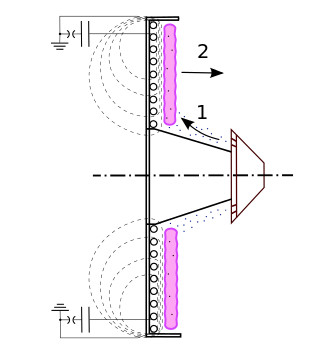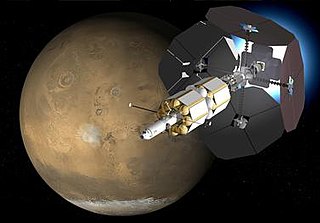Related Research Articles

Spacecraft propulsion is any method used to accelerate spacecraft and artificial satellites. In-space propulsion exclusively deals with propulsion systems used in the vacuum of space and should not be confused with space launch or atmospheric entry.

In spacecraft propulsion, a Hall-effect thruster (HET) is a type of ion thruster in which the propellant is accelerated by an electric field. Hall-effect thrusters are sometimes referred to as Hall thrusters or Hall-current thrusters. Hall-effect thrusters use a magnetic field to limit the electrons' axial motion and then use them to ionize propellant, efficiently accelerate the ions to produce thrust, and neutralize the ions in the plume. The Hall-effect thruster is classed as a moderate specific impulse space propulsion technology and has benefited from considerable theoretical and experimental research since the 1960s.

An ion thruster, ion drive, or ion engine is a form of electric propulsion used for spacecraft propulsion. It creates thrust by accelerating ions using electricity.

A magnetoplasmadynamic (MPD) thruster (MPDT) is a form of electrically powered spacecraft propulsion which uses the Lorentz force to generate thrust. It is sometimes referred to as Lorentz Force Accelerator (LFA) or MPD arcjet.

A mass driver or electromagnetic catapult is a proposed method of non-rocket spacelaunch which would use a linear motor to accelerate and catapult payloads up to high speeds. Existing and contemplated mass drivers use coils of wire energized by electricity to make electromagnets, though a rotary mass driver has also been proposed. Sequential firing of a row of electromagnets accelerates the payload along a path. After leaving the path, the payload continues to move due to momentum.

A magnetic sail is a proposed method of spacecraft propulsion where a spacecraft shown as a purple dot in the center of the illustration has a source that generates a magnetic field, which under certain conditions, summarized in the overview section, creates a magnetopause and a bow shock that deflect a plasma wind of charged particles. A low density region forms creating an artificial magnetospheric bubble around the spacecraft. The term magnetospheric object refers to the magnetosphere, magnetopause and the bow shock. Charged particles in the plasma deflected by the bow shock and magnetopause together create an effective sail blocking area that exerts a wind force that acts on the magnetic field, which in turn exerts a magnetic force on the field source that creates a spacecraft force that accelerates the spacecraft in the same direction as the plasma wind.
Beam-powered propulsion, also known as directed energy propulsion, is a class of aircraft or spacecraft propulsion that uses energy beamed to the spacecraft from a remote power plant to provide energy. The beam is typically either a microwave or a laser beam and it is either pulsed or continuous. A continuous beam lends itself to thermal rockets, photonic thrusters and light sails, whereas a pulsed beam lends itself to ablative thrusters and pulse detonation engines.

A fusion rocket is a theoretical design for a rocket driven by fusion propulsion that could provide efficient and sustained acceleration in space without the need to carry a large fuel supply. The design requires fusion power technology beyond current capabilities, and much larger and more complex rockets.

An antimatter rocket is a proposed class of rockets that use antimatter as their power source. There are several designs that attempt to accomplish this goal. The advantage to this class of rocket is that a large fraction of the rest mass of a matter/antimatter mixture may be converted to energy, allowing antimatter rockets to have a far higher energy density and specific impulse than any other proposed class of rocket.

A pulsed inductive thruster (PIT) is a form of ion thruster, used in spacecraft propulsion. It is a plasma propulsion engine using perpendicular electric and magnetic fields to accelerate a propellant with no electrode.

The Variable Specific Impulse Magnetoplasma Rocket (VASIMR) is an electrothermal thruster under development for possible use in spacecraft propulsion. It uses radio waves to ionize and heat an inert propellant, forming a plasma, then a magnetic field to confine and accelerate the expanding plasma, generating thrust. It is a plasma propulsion engine, one of several types of spacecraft electric propulsion systems.
A propellant is a mass that is expelled or expanded in such a way as to create a thrust or another motive force in accordance with Newton's third law of motion, and "propel" a vehicle, projectile, or fluid payload. In vehicles, the engine that expels the propellant is called a reaction engine. Although technically a propellant is the reaction mass used to create thrust, the term "propellant" is often used to describe a substance which contains both the reaction mass and the fuel that holds the energy used to accelerate the reaction mass. For example, the term "propellant" is often used in chemical rocket design to describe a combined fuel/propellant, although the propellants should not be confused with the fuel that is used by an engine to produce the energy that expels the propellant. Even though the byproducts of substances used as fuel are also often used as a reaction mass to create the thrust, such as with a chemical rocket engine, propellant and fuel are two distinct concepts.

Laser propulsion is a form of beam-powered propulsion where the energy source is a remote laser system and separate from the reaction mass. This form of propulsion differs from a conventional chemical rocket where both energy and reaction mass come from the solid or liquid propellants carried on board the vehicle.
The helicon double-layer thruster is a prototype spacecraft propulsion engine. It was created by Australian scientist Christine Charles, based on a technology invented by Professor Rod Boswell, both of the Australian National University.
The electrodeless plasma thruster is a spacecraft propulsion engine commercialized under the acronym "E-IMPAcT" for "Electrodeless-Ionization Magnetized Ponderomotive Acceleration Thruster". It was created by Gregory Emsellem, based on technology developed by French Atomic Energy Commission scientist Dr Richard Geller and Dr. Terenzio Consoli, for high speed plasma beam production.

A plasma propulsion engine is a type of electric propulsion that generates thrust from a quasi-neutral plasma. This is in contrast with ion thruster engines, which generate thrust through extracting an ion current from the plasma source, which is then accelerated to high velocities using grids/anodes. These exist in many forms. However, in the scientific literature, the term "plasma thruster" sometimes encompasses thrusters usually designated as "ion engines".

Spacecraft electric propulsion is a type of spacecraft propulsion technique that uses electrostatic or electromagnetic fields to accelerate mass to high speed and thus generate thrust to modify the velocity of a spacecraft in orbit. The propulsion system is controlled by power electronics.

TAU was a proposed uncrewed interstellar probe that would go to a distance of one thousand astronomical units from the Earth and Sun by the NASA Jet Propulsion Laboratory in 1987 using tested technology. One scientific purpose would be to measure the distance to other stars via stellar parallax. Studies continued into 1990, working with a launch in the 2005–2010 timeframe.
A Propulsive Fluid Accumulator is an artificial Earth satellite which collects and stores oxygen and other atmospheric gases for in-situ refuelling of high-thrust rockets. This eliminates the need to lift oxidizer to orbit and therefore brings significant cost benefits. A major portion of the total world payload sent into low Earth orbit each year is either liquid oxygen or water.
Atmosphere-breathing electric propulsion, or air-breathing electric propulsion, shortly ABEP, is a propulsion technology for spacecraft, which could allow thrust generation in low orbits without the need of on-board propellant, by using residual gases in the atmosphere as propellant. Atmosphere-breathing electric propulsion could make a new class of long-lived, low-orbiting missions feasible.
References
- ↑ "MagBeam". Earthweb.ess.washington.edu. 2011-11-17. Retrieved 2014-07-15.
- ↑ Celeste Biever "Magnetic beams could power swifter spacecraft", New Scientist, 18 October 2004
- ↑ University of Washington, New propulsion concept could make 90-day Mars round trip possible Archived 2009-07-21 at the Wayback Machine , Oct. 14, 2004
- ↑ G. A. Landis, "Interstellar Flight by Particle Beam," STAIF Conference on Innovative Transportation Systems for Exploration of the Solar System and Beyond, Albuquerque NM, Feb. 11-15, 2001. AIP Conference Proceedings Volume 552, 393-396. See also Acta Astronautica, Volume 55, Issue 11, December 2004, Pages 931-934 (link)
- ↑ "Newfangled space-propulsion technology could help clean up Earth orbit". Phys.org. 2012-04-11. Retrieved 2013-08-31.